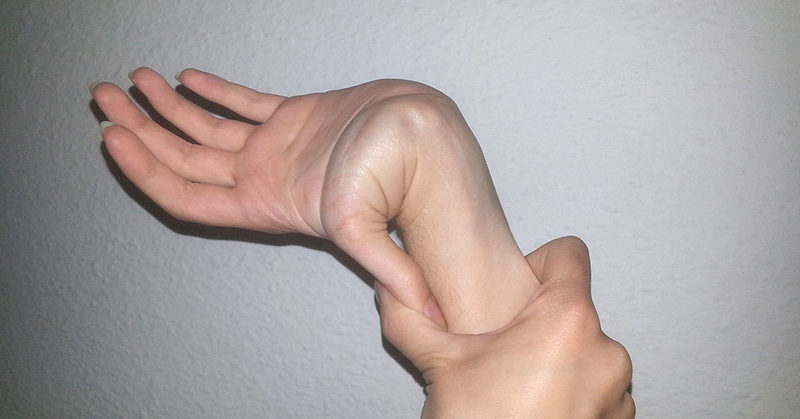Ehlers-Danlos syndrome is a group of disorders that affect the connective tissues of the body that support bones, blood vessels, skin, tissues and organs. As a result, people with this disease commonly experience loose joints and stretchy skin. Individuals with this illness also have problems with collagen, which is a protein that adds elasticity and strength to your skin. The condition has various stages ranging from loose joints to life-threatening problems. Worldwide this illness affects 1 in 5,000 people. (1, 2) This condition is also known as EDS and Ehlers Danlos Disease. While this condition is not yet curable, it is treatable.
Symptoms and Complications

While there are currently thirteen variations of the illness, some of the most common symptoms they share are hypermobility, stretchy skin, and easily bruised skin. The cause of EDS includes inheritance, genetic patterns, and in extremely rare cases, genetic spontaneous mutations. (1, 2, 3) Many times symptoms are joint and skin-related. They also vary based on what type of EDS you have. Some of the symptoms and complications can include:
- loose joints
- elastic skin
- easily bruised skin
- muscle pain or fatigue
- transparent skin
- heart valve problems
- chronic pain
- chronic degenerative joint disease
- fragile skin
- large hernias
- slow wound healing
Read More: New Recommendation Calls for Anxiety Disorder Screening in Adults
EDS Symptoms Can be Poorly Understood

It’s important to talk with your doctor to determine if you have EDS. Some of the tests used to diagnose EDS include genetic testing, an echocardiogram (if you have heart problems), blood work, and skin biopsy. Since this disease is rare many practitioners are not familiar with this condition. This can lead to inaccurate diagnosis and many patients may wait years before they receive an accurate diagnosis. Due to the rarity of the disease, many extra-articular symptoms may seem unrelated to the untrained or inexperienced eye. (3)
Some of the extra-articular disorders associated with EDS can include:

- anxiety
- chronic fatigue
- carpal tunnel
- Crohn’s disease
- fibromyalgia
- hiatus hernia
- urinary stress incontinence
- postural tachycardia syndrome
- chronic constipation
Read More: Common Mental Health Disorder May Triple Risk for Developing Dementia, Study Finds
How to Manage Ehlers-Danlos Syndrome

Conventional treatment for this illness includes prescription pain medications, over-the-counter pain medication, surgery, and blood pressure medicine. Living a preventative lifestyle may help to reduce complications of this illness. You should always speak with your doctor about making any changes to your health care plan, as not every option is appropriate for every individual. There is increasing evidence that symptoms of genetic conditions can be alleviated and influenced by nutrition. Researchers are investigating how supplements such as calcium, carnitine, coenzyme Q10, glucosamine, magnesium, methyl sulphonyl methane, pycnogenol, silica, vitamin C, and vitamin K, can benefit EDS symptoms. (4)
Common tips include:

- Avoid physical stress
- Avoid strenuous activities
- Pamper your skin
- Avoid injuries
- Use only low-impact exercise and physical therapy
- Find a support group
- Consider nutritional supplements
Conclusion

Getting an accurate diagnosis for EDS may take some time, as finding a knowledgeable doctor for this rare illness may take some research. Most of the conventional treatments available focus mainly on symptom reduction such as physical therapy, drugs to minimize pain, and in rare cases surgery to repair damaged joints. Talk with your doctor to see if nutritional supplements are an option for you. You can learn more about EDS at the Ehlers-Danlos Society
Read More: 5 of the most ignored symptoms that could mean you have a thyroid disorder
- Ehlers-Danlos Syndrome: Causes, Symptoms, and Diagnosis. (n.d.). Retrieved August 7, 2018, from https://www.healthline.com/health/ehlers-danlos-syndrome#causes2. Ehlers-Danlos syndrome – Genetics Home Reference – NIH. (n.d.). Retrieved August 7, 2018, from https://ghr.nlm.nih.gov/condition/ehlers-danlos-syndrome
- Castori, M. (2012, November 22). Ehlers-Danlos Syndrome, Hypermobility Type: An Underdiagnosed Hereditary Connective Tissue Disorder with Mucocutaneous, Articular, and Systemic Manifestations. Retrieved August 7, 2018, from https://www.ncbi.nlm.nih.gov/pmc/articles/PMC3512326/
- Mantle, D., Wilkins, R. M., & Preedy, V. (2004, July 23). A novel therapeutic strategy for Ehlers-Danlos syndrome based on nutritional supplements. Retrieved August 7, 2018, from https://www.ncbi.nlm.nih.gov/pubmed/15607555

